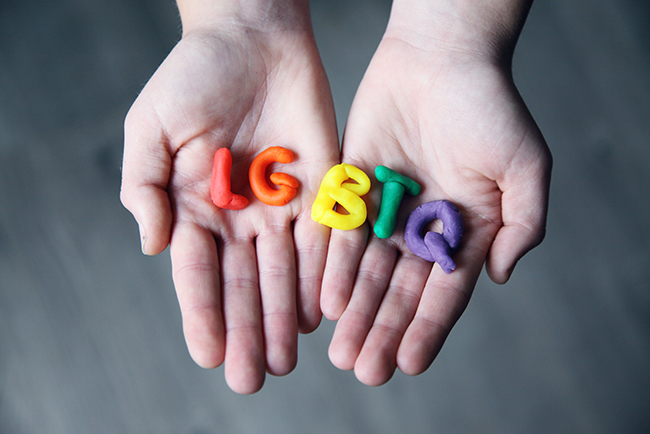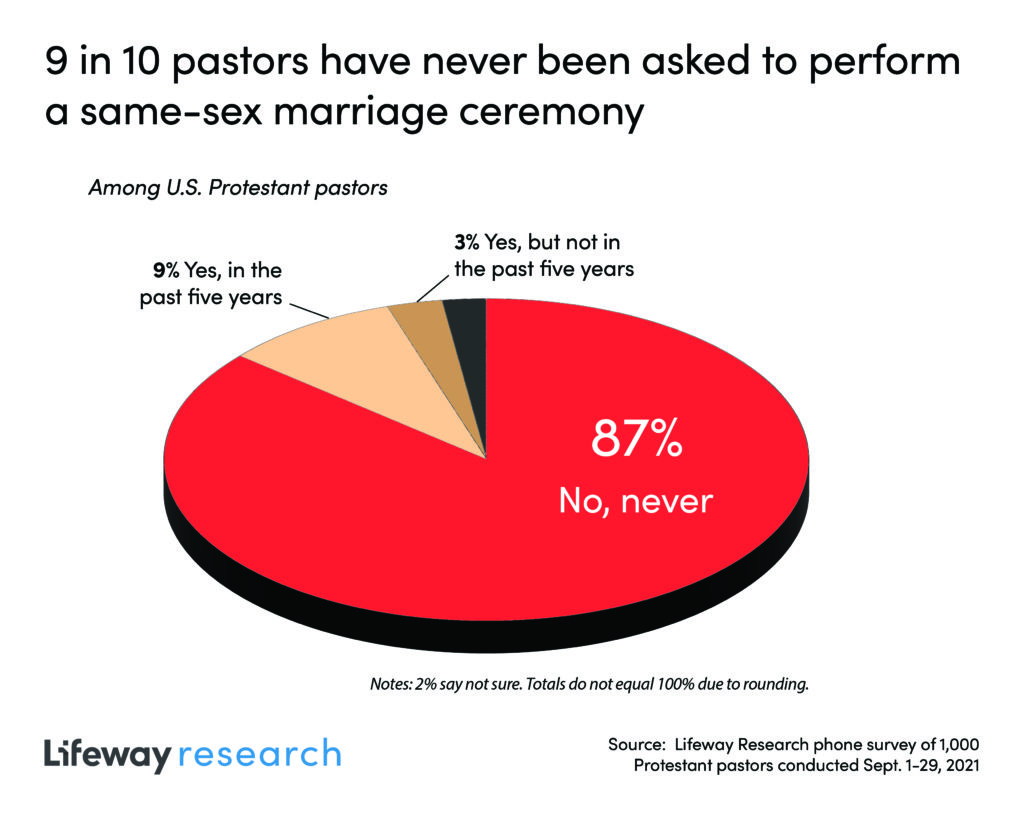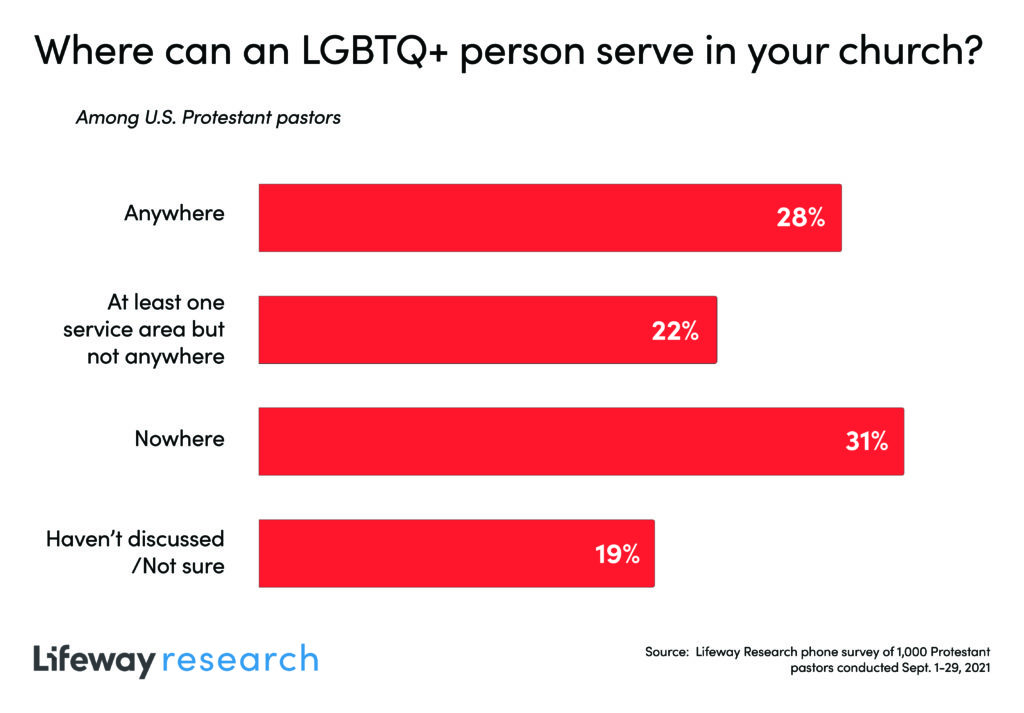
Although most pastors haven’t been asked to marry a same-sex couple, many have guidelines on where LGBTQ+ people can serve in their churches.
By Marissa Postell
This month marks seven years since the Supreme Court legalized same-sex marriage with its Obergefell v. Hodges decision. Five years later, the 2020 American Community Survey from the United States Census Bureau estimated there were more than 570,000 same-sex married couple households in the United States.
But most of these same-sex couples did not ask a Protestant pastor to marry them. A study from Lifeway Research found 87% of Protestant pastors have never been asked to perform a same-sex marriage ceremony. Of those who have been asked, 9% have been asked within the past five years, while 3% say it’s been over five years since they were asked to perform a same-sex marriage ceremony. At the time of a 2016 study from Lifeway Research, 88% of Protestant pastors had never been asked to perform a same-sex wedding, and 11% had been asked.
87% of Protestant pastors say they have never been asked to perform a same-sex marriage ceremony. Click To TweetBaptist (4%) and non-denominational (4%) pastors are least likely to say they have been asked to perform a same-sex wedding ceremony. And Presbyterian/Reformed pastors are most likely to have been asked (26%).
Overall, mainline pastors are nearly three times as likely as evangelical pastors to have ever been asked to marry a same-sex couple (20% vs. 7%). And female pastors (17%) are almost twice as likely as male pastors (9%) to have been asked.

“There are signs there may have been an initial surge of requests or a discovery process to see which churches would perform same-sex weddings shortly after it became legal in all 50 states,” said Scott McConnell, executive director of Lifeway Research. “But overall, the prevalence of inquiries to pastors has been fairly consistent.”
Different service opportunities in churches
Although most pastors haven’t been asked to perform weddings for same-sex couples, many have guidelines of where an LGBTQ+ person can serve in their churches. But guidelines vary significantly across the Protestant church landscape.
28% of U.S. Protestant pastors say LGBTQ+ individuals can serve anywhere in their church, while 31% say there is nowhere they can serve. Click To TweetFewer than one-third of Protestant pastors do not allow LGBTQ+ people to serve at their churches in any capacity (31%), compared to 34% in 2016. While 28% of Protestant pastors say LGBTQ+ people can serve anywhere in their churches, others have limitations. In 2016, 30% of pastors said LGBTQ+ people could serve anywhere in their churches, while 15% said they could serve in some areas. Today, 22% of pastors say LGBTQ+ people can serve in at least one service area, but not anywhere in the church. Protestant pastors are more willing to allow LGBTQ+ people to serve in helping and service roles (44%) than public worship (24%), public teaching (25%) or public leadership (25%) roles.
Another 7% of pastors say they’re not sure where an LGBTQ+ person can serve in their churches, and 14% say they haven’t discussed the issue.

“Overall, more pastors indicate LGBTQ+ persons may serve somewhere in their churches today compared to 2016,” McConnell said.
Lack of uniformity over LGBTQ+ roles in churches
Although mainline pastors are more likely than evangelicals to be open to having LGBTQ+ people serve in their churches, it is not a clear-cut stereotype. Half of mainline pastors (52%) say LGBTQ+ people can serve anywhere in their churches. Many mainline pastors (61%) say LGBTQ+ people can serve in helping and service roles. But they are more divided over whether they can hold public-facing worship (45%), teaching (48%) or leadership (47%) roles. Still, 13% of mainline pastors say LGBTQ+ people cannot serve in their churches.
Many evangelical pastors are open to having LGBTQ+ people serve in some capacity in their churches. While 12% of evangelical pastors say LGBTQ+ people can serve anywhere in their churches, less than half (41%) say there are no service opportunities in their churches. Evangelical pastors are less likely than mainline pastors to say LGBTQ+ people can lead worship (11%), teach (11%) or hold leadership (12%) roles. More say they can serve in helping and service roles (36%).
“Knowing if a Protestant church is mainline or evangelical is a good clue whether they might include LGBTQ+ persons in service and leadership in the church, but it’s far from indicative." — @smcconn Click To Tweet“Knowing if a Protestant church is mainline or evangelical is a good clue whether they might include LGBTQ+ persons in service and leadership in the church, but it’s far from indicative,” McConnell said. “Churches across traditions interpret and apply biblical standards for leadership and fellowship in the local church quite differently.”
Female pastors are also more likely than male pastors to be open to LGBTQ+ people serving in their churches. Half of female pastors (51%) say an LGBTQ+ person can serve anywhere in their churches, compared to 1 in 5 male pastors (20%) who say the same. Female pastors are also more likely than male pastors to say LGBTQ+ people can serve in both front-facing and behind-the-sense service roles. More female pastors than males say LGBTQ+ people can serve in helping or service roles (57% v. 39%), public worship roles (42% v. 17%), public teaching roles (43% v. 18%) and public leadership roles (43% v. 18%). Male pastors (37%) are more than twice as likely as female pastors (15%) to say LGBTQ+ people can’t serve anywhere in their churches.
For more information, view the complete report.

Methodology
The phone survey of 1,000 Protestant pastors was conducted by Lifeway Research Sept. 1-29, 2021. The calling list was a stratified random sample, drawn from a list of all Protestant churches. Quotas were used for church size. Each interview was completed by the senior or sole pastor or a minister at the church. Responses were weighted by region and church size to more accurately reflect the population. The completed sample is 1,000 surveys. The sample provides 95% confidence the sampling error does not exceed plus or minus 3.2%. This margin of error accounts for the effect of weighting. Margins of error are higher in sub-groups.







